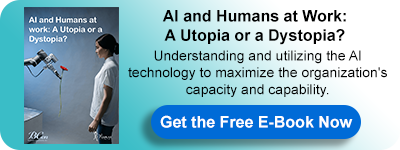How Organizations Orchestrate AI and Employees
During all the changes taking as AI progresses into our lives and into our workplaces, how should leaders handle this technological transition?
1. Be crystal clear about your AI approach and value proposition.
Explain how AI will benefit employees so that they can adapt to the changes with a positive attitude. By being open and honest about how things will change, you can address employee concerns and allay any fears they may have. Some employees may adapt quickly (for example, according to a ServiceNow survey, 43 percent of Generation Z members desire to use AI on the job), while others will take longer. According to Alarcon, HR specialists must ensure that everyone is supported.
2. Describe how AI may improve the employee experience.
Demonstrate how AI can be used to manage all of the administrative, repetitive duties that employees despise and how it can enable them to enjoy new and significant experiences at work. According to Anne Fulton, CEO of career experience platform Fuel50, AI may serve as a journey accelerator for employees, giving them the tools to go from new recruit to team rock star in no time if used right.
3. Look into how AI may assist employees in ways other than eliminating manual tasks.
To improve the employment experience, get people to consider the potential future benefits of AI. Consider a near-future scenario in which an AI bot identifies that an employee is working on a new project and could benefit from some additional background information, so an educational video is provided to that person. Perhaps AI can detect a shift in an employee's mood and notify management, prompting the boss to offer a more extended lunch break. According to Alarcon, continue to look into the various ways AI might bring value.
4. Encourage an innovation and development culture among employees to gain a feeling of purpose and inventiveness in their work.
5. Disseminate achievements and best practices.
Make a list of critical KPIs you'd like to see improve from incorporating AI, such as your upskilling initiatives, and keep track of your progress. Like any other technology, adding AI might be intimidating at first. Still, it's crucial to remember why it was needed and introduced in the first place ad According to Jessica Rush, chief talent officer at conversational AI software company Paradox. This creates momentum.
6. Invest in Learning and education.
According to a recent IBM Institute for Business Value study, we will need to train and reskill millions of workers due to AI over the next three years. Technical training will almost definitely be required. Executives and managers will need to focus on preparing workers for the future by cultivating and growing "people skills" such as judgment, complex problem solving, creativity, and the capacity to communicate effectively as the importance of tasks requiring intellectual skill, insight, and other distinctively human traits arise. As jobs evolve and change in value, leaders may assist their staff in transitioning to collaborating with intelligent robots.
7. Soft skills will become progressively more vital as AI becomes more common.
As firms adopt rule-based thinking and automation, abilities such as sensitivity, originality, verbal reasoning and communication, empathy, and spontaneity may become more valued. HR or a new Humanity Department can help with this component of personal growth that ensures organizations get the most out of the interaction between human and artificial intelligence.
1SHRM, 30 Nov 2020, Joseph Romsey, 5 Tips to help workers upskill and adapt to artificial intelligence, Accessed 6
Mar 2022, https://www.shrm.org/resourcesandtools/hr-topics/technology/pages/how-hr-can-help-workers-upskill-and-adapt-to-artificial-intelligence-5-tips.aspx
HBR, 24 Mar 2020, Martin Fleming, AI is changing work-and leaders need to adapt, accessed 5 Mar 2022, https://hbr.org/2020/03/ai-is-changing-work-and-leaders-need-to-adapt
For more about this topic, download our latest book " AI and Humans at Work: A Utopia or a Dystopia? " for FREE:
